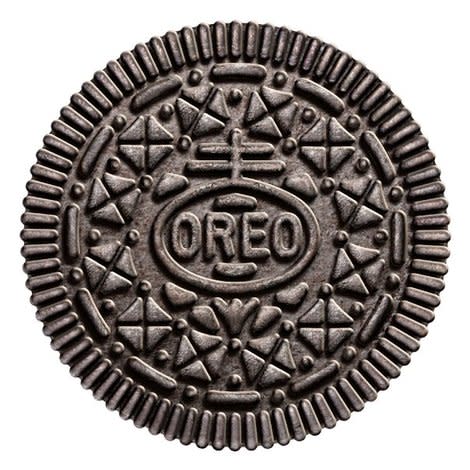100 Years of Oreo: Recipes and Facts About the Famous Cookie

The Oreo cookie turns 100 today, and a full century of milk-dipping, creme-scraping deliciousness later, they're still they're one of the most popular treats in the world.
Originally called the Oreo biscuit, they were created in a National Biscuit Company bakery in Manhattan on March 6, 1912. Now, more than 95 million cookies are sold every day in more than 100 countries, generating $1.5 billion in revenue each year.
Becky Tousey, Kraft Foods' corporate archivist, says that the brand's message hasn't changed over the course of a century.
"The focus of advertising was on the fun of eating Oreos, the fun of the parts of the Oreo," she told ABC News. "It has that theme of the enjoyment -- the twisting, the licking, the dunking. For me, as a historian, it's fun to see that thread throughout."
Though there are plenty of iterations of the Oreo out there -- in 2011, the Triple Double was born, with two flavors of creme and three layers of wafer all stacked together, and Kraft Foods launched a trial run of a special birthday edition Oreo this year, with sprinkle-dusted cake-flavored creme -- home cooks and professional bakers alike have taken Oreos to a higher level, incorporating the iconic cookie into a host of mouth-watering desserts.
Here are two of our favorite recipes using the iconic cookie:
Oreo-stuffed chocolate chip cookies:
Bon Appetit magazine calls these "the new cupcake." (Pretending to be healthy? Try this oatmeal cookie-oreo version.)
2 sticks softened butter
3/4 cup packed light brown sugar
1 cup granulated sugar
2 large eggs
1 tablespoon pure vanilla
3 1/2 cups flour
1 teaspoon salt
1 teaspoon baking soda
10 oz bag chocolate chips
1 pkg. Oreo cookies
Preheat oven to 350 degrees. Cream butter and sugars together with a mixer until well combined. Beat in eggs and vanilla.
In a separate bowl mix the flour, salt and baking soda. Slowly add to wet ingredients along with chocolate chips until just combined. Using a cookie scoop take one scoop of cookie dough and place on top of an Oreo Cookie. Take another scoop of dough and place on bottom of Oreo cookie. Seal edges together by pressing and cupping in hand until Oreo cookie is enclosed with dough. Place onto a parchment or silpat lined baking sheet and bake cookies 9-13 minutes or until golden brown. Let cool for 5 minutes before transferring to cooling rack.
Makes about 2 dozen large cookies.
Triple-chocolate cookie balls
This no-bake treat that looks much more complicated than it really is.
1 pkg. Oreo cookies
1/2 cup milk
1 package JELL-O chocolate instant pudding
12 to 16 Baker's semi-sweet chocolate squares
4 to 8 Bakers white chocolate squares
In a small bowl, make a paste out of the pudding and the milk. Put 36 of the Oreos into a gallon-size zip-top bag and crush them (with a rolling pin or a mallet). Add the crushed cookies to the pudding mixture and stir will. Form the mixture into small balls and place on a wax-paper lined cookie sheet; freeze them for about 10 minutes.
While they're in the freezer, please the semi-sweet chocolate squares in a microwave-safe bowl and heat, stirring often, until melted. Dip the chilled Oreo balls into the melted chocolate, place them on a fresh wax-paper lined cookie sheet, and refrigerate or freeze for another 10 minutes.
Melt the white chocolate squares, and drizzle the melted white chocolate over the cookie balls using a fork or a spoon. Return them to the refrigerator to harden briefly before serving.
Makes 40 to 45 cookie balls
If you're counting your calories, these pieces of Oreo trivia are totally diet-friendly:
Which came first, Oreo or Hydrox? Though both have passionate followings, and Oreos outsell the Kellogg Hydrox sandwich cookie, Hydrox cookies actually came first, in 1908. They were discontinued in 1999, but returned to stores in 2008.
According to Kraft Foods, 84 percent of men and 59 percent of women eat the cookie without twisting it open first.
No one knows who came up with Oreos, or where the name really came from. Kraft Foods' corporate archivist Becky Tousey says that she thinks the name came from combining the "re" in creme and the two "o's" in chocolate. Others theorize that the name comes from the ancient Greek word for mountain ("oros") since the cookies were once domed, or the French word for gold ("or") because the cookies once came in golden packaging.
Oreos are available in different flavors outside of the U.S.. In China you can find them in Green Tea, orange/mango, and raspberry/blueberry "Double Fruit" flavors. In Argentina, there's the Oreo Alfajor, with a half-banana, half-dulce de leche flavored filling. In Mexico, people enjoy "Trio Chocolate," with three different types of chocolate in each cookie, and Oreos with a cookies-and-creme filling (that's right -- Oreo cookies with Oreo-cookie filling, so to speak.)
Classic Oreos are 71 percent chocolate wafer and 29 percent creme. After decades of this standard, the company released the Double Stuff in 1975.
There's at least one street named after the cookie: Oreo Way, in New York City.
It takes 59 minutes for a bakery to make an Oreo.
The tiny pattern pressed into the wafer is a combination of 12 flowers (each made of 4 triangles), 37 dots, and 12 dashes. Each cookie also has 90 ridges running along its edges.
Copyright © 2012 Yahoo Inc.
Also on Shine:
6 creative ways to use Oreos
Iconic American cookie tastes different overseas
The new triple-stuffed Oreo and 10 other remakes of the original cookie
Cake batter Oreos
Black-and-white pudding squares
